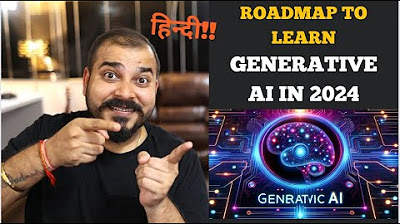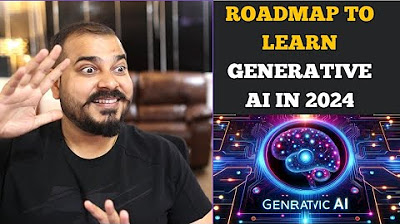Generative AI Vs NLP Vs LLM - Explained in less than 2 min !!!
Summary
TLDRThis video script introduces the concepts of generative AI, natural language processing (NLP), and large language models. Generative AI is likened to an artist, creating new content from data inputs, which could be text, code, images, audio, or video. NLP is a subset focusing on models that understand and generate human language, performing tasks like translation and summarization. Large language models, a subset of NLP, are trained on vast text data to create highly relevant and coherent creative text. Examples include chatbots like Chat GBT, Microsoft Co-Pilot, and Google Gemini. The video promises future tutorials on creating custom chatbots.
Takeaways
- 🤖 Generative AI is like an artist that creates new content from data inputs.
- 🎨 The creative outputs of generative AI can include text, code, images, audio, and even videos.
- 📚 Natural Language Processing (NLP) is a subset of generative AI focused on understanding and generating human language.
- 🌐 NLP models can perform various tasks such as translation and summarization.
- 📚 Large language models are a specific type of NLP that are trained on vast amounts of text data.
- 💡 Large language models can generate new, coherent, and relevant text based on the data they were trained on.
- 🔍 Examples of large language models include Chat GBT, Microsoft Co-Pilot, Google Gemini, and more.
- 🛠️ The video promises to show viewers how to create their own chatbot using personal data in upcoming videos.
- 📈 Large language models are significant in the AI field for their ability to produce highly coherent text.
- 🔗 The script emphasizes the relationship between generative AI, NLP, and large language models.
- 👨🏫 The video aims to educate viewers on the differences and applications of these AI concepts.
Q & A
What is generative AI?
-Generative AI refers to models that can create new, creative content from given data. It's like an artist with algorithms, capable of producing text, code, images, audio, and even videos.
How is generative AI different from natural language processing (NLP)?
-While generative AI is a broad concept that includes creating various types of content, NLP is a subset of generative AI specifically focused on understanding, interpreting, and generating human language.
What tasks can natural language processing models perform?
-NLP models can perform tasks such as translation, summarization, and other language-related tasks that involve understanding and generating human language.
What are large language models?
-Large language models are a subset of NLP, trained on vast amounts of text data, and capable of creating highly relevant and coherent new text content.
Can you provide examples of large language models mentioned in the script?
-Examples of large language models mentioned include Chat GBT, Microsoft Co-Pilot, and Google Gemini.
What is the main purpose of large language models?
-The main purpose of large language models is to generate new, creative, and contextually relevant text based on the data they have been trained on.
How do generative AI models differ from traditional AI models?
-Generative AI models differ from traditional AI models in that they are not just recognizing patterns or making predictions; they are capable of creating entirely new content from the data they process.
What is the significance of training large language models on vast amounts of text data?
-Training on vast amounts of text data allows large language models to understand the nuances and complexities of human language, enabling them to generate more accurate and contextually relevant responses.
What does the script suggest about the future content of the channel?
-The script suggests that future videos on the channel will demonstrate how to create your own chatbot using your own data.
Why is it important for viewers to subscribe to the channel?
-It is important for viewers to subscribe to stay updated on the latest videos, including upcoming tutorials on creating a custom chatbot.
What does the analogy of 'giving paints to an artist' imply about generative AI?
-The analogy implies that, like an artist uses paints to create paintings, generative AI uses input data to create new and creative content.
Outlines

This section is available to paid users only. Please upgrade to access this part.
Upgrade NowMindmap

This section is available to paid users only. Please upgrade to access this part.
Upgrade NowKeywords

This section is available to paid users only. Please upgrade to access this part.
Upgrade NowHighlights

This section is available to paid users only. Please upgrade to access this part.
Upgrade NowTranscripts

This section is available to paid users only. Please upgrade to access this part.
Upgrade NowBrowse More Related Video

Introduction to Generative AI

Roadmap to Learn Generative AI(LLM's) In 2024-Krish Naik Hindi #generativeai

Introduction to Generative AI n explainable AI

Natural Language Processing: Crash Course AI #7

The History of Natural Language Processing (NLP)

Roadmap to Learn Generative AI(LLM's) In 2024 With Free Videos And Materials- Krish Naik
5.0 / 5 (0 votes)